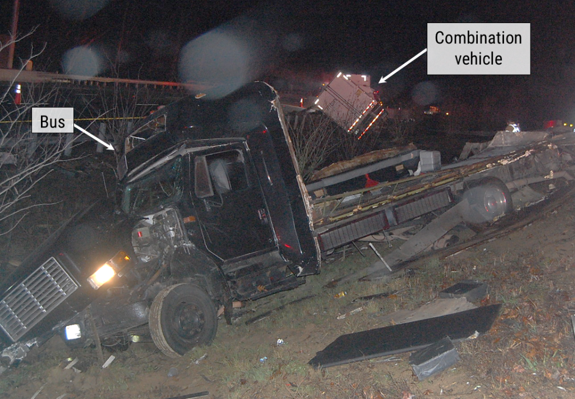On Friday, December 16, 2022, about 1:36 a.m. eastern standard time, a truck tractor in combination with a semitrailer (combination vehicle), operated by Triton Logistics Incorporated, was traveling east on Interstate 64 (I 64) near Williamsburg, York County, Virginia, when it crashed into the rear of a slower moving medium-size bus, operated by Futrell’s Party Adventures, LLC. Both vehicles were traveling in the right eastbound lane. In the 5 seconds before the crash, the bus was traveling at a speed of about 20 to 25 mph, while the combination vehicle was traveling between 65 and 70 mph with cruise control activated. The speed limit on I 64 is 70 mph. The truck driver, the sole occupant in the combination vehicle, did not brake or take any evasive action as he approached the slower moving bus. During the collision with the truck tractor, the roof and sidewalls of the bus separated from the rest of the vehicle, exposing the occupant compartment. After the collision, the bus rotated counterclockwise around the front of the truck tractor, crossed over the left eastbound lane, and breached the eastbound median guardrail. The truck tractor continued forward on a southeast trajectory relative to the roadway, across the travel lanes, shoulder, and median. As a result of the crash, 3 bus occupants died, 9 sustained serious injuries, and 11 sustained minor injuries. The truck driver also sustained serious injuries.

Eastbound view of final rest positions of the bus and combination vehicle (Source: Virginia State Police with annotations by the NTSB).
We found that the truck driver’s lack of response to the slow-moving vehicle in his travel lane was due to fatigue from excess driving time and lack of sleep opportunity. The truck’s motor carrier, Triton Logistics Incorporated, created fictitious driver accounts for its vehicles’ electronic logging device systems that enabled drivers to operate beyond federal regulations, creating an opportunity for fatigued driving. The ability to track data entry in the electronic logging device software could increase accountability and transparency and deter motor carriers from making false entries aimed at circumventing hours-of-service regulations.
We found that a comprehensive fatigue management program can reduce fatigue related crash risk and improve safety by, for example, educating drivers; had Triton had such a program, the driver may not have been operating the truck while fatigued. In addition, inward-facing video enhances the effectiveness of driver coaching programs and can reduce instances of violations of carrier safety policies.
Advanced vehicle technologies, including automatic emergency braking and adaptive cruise control, were available as standard equipment for this truck-tractor; however, the carrier opted not to purchase these systems. We found that the collision may have been avoided or its severity lessened had these systems been installed on the truck tractor. Because commercial vehicle customers can elect not to purchase collision avoidance systems, even those that are considered standard equipment, federal requirements are necessary to increase widespread deployment of this technology.
We found that the slow speed of the bus increased the severity of the collision and may have been due, in part, to a partially blocked prescreen fuel filter. The bus carrier lacked appropriate safety management practices, as demonstrated by the poor maintenance and improper registration of the bus and use of an improperly licensed driver. In addition, the Commonwealth of Virginia did not provide safety guidance to new motor carrier licensees, increasing the likelihood that new carriers could operate without knowledge of safety regulations and best practices.
We determined that the probable cause of the Williamsburg, Virginia, crash was the truck driver’s fatigue, due to excessive driving time and limited sleep opportunity, which resulted in his lack of response to the slow moving bus ahead. Contributing to the truck driver’s fatigue was the motor carrier, Triton Logistics Incorporated, which created fictitious driver accounts in the electronic logging device system and enabled drivers to operate their vehicles for hours in excess of federal regulations. Contributing to the severity of the crash was the operation of the bus at a significantly slower speed than other highway traffic.
As a result of this investigation, we issued six new safety recommendations and reiterated three recommendations. We recommended that the Federal Motor Carrier Safety Administration revise federal regulations to require providers of electronic logging devices to create and produce an audit log, to include date, time and editor for driver logins, driver’s license numbers, and active driver list changes. We recommended that the Commonwealth of Virginia provide new intrastate motor carrier licensees with safety guidance such as proper license class, drug- and alcohol testing requirements, fatigue management, vehicle maintenance, and safe commercial vehicle operation. We also recommended that Triton Logistics Incorporated implement a process to regularly verify the accuracy of driver records of duty status, implement a fatigue management program to educate its drivers and other employees about fatigue, and proactively use onboard video event recorder information, including inward and forward facing video, to enhance driver training/coaching. Finally, we recommended that the Commercial Vehicle Safety Alliance inform its members of this crash, including the potential consequences of false log information.
We reiterated Safety Recommendation H 15 5 to the National Highway Traffic Safety Administration to complete the development and application of performance standards and protocols for the assessment of forward collision avoidance systems in commercial vehicles, and Safety Recommendation H 22 3 to require that all buses and trucks over 10,000 pounds gross vehicle weight rating be equipped with onboard video event recorders. Finally, we reiterated Safety Recommendation H 22 4 to the Federal Motor Carrier Safety Administration to provide guidance to motor carriers to proactively use the onboard video event recorder information to aid in driver training and ensure driver compliance with regulatory rules essential for safe operation.